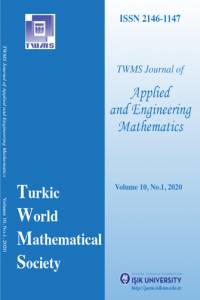G.GHORAI, M.PAL: APPLICATIONS OF BIPOLAR FUZZY SETS IN INTERVAL GRAPHS
Currently, bipolar fuzzy graph is a growing research topic as it is the generalization of fuzzy graphs. In this paper, normal and convex bipolar fuzzy sets are defined and the notion of bipolar fuzzy interval is introduced as a generalization of fuzzy interval and described various methods of their construction. It is shown that intersection of two bipolar fuzzy intervals may not be a bipolar fuzzy interval. Finally, bipolar fuzzy interval graphs is introduced as the intersection graph of a finite family of bipolar fuzzy intervals. The relationship between the intersection graph of a {α, β}-level family of bipolar fuzzy intervals and {α, β}-cut of the intersection graph for that family have been established. It is proved that for every bipolar fuzzy interval graph G, the α, β -cut level graph G α β is an interval graph for each α, β ∈ 0, 1] × [−1, 0 . Also, some important hereditary properties of bipolar fuzzy interval graphs are presented.
Keywords:
Bipolar fuzzy set, Normal and convex bipolar fuzzy set Bipolar fuzzy interval, Bipolar fuzzy interval graph,
___
- Akram, M., (2011), Bipolar fuzzy grpahs, Information Sciences, 181 (24), pp. 5548-5564.
- Akram, M., (2013), Bipolar fuzzy grpahs with applications, Knowledge-Based Systems, 39, pp. 1-8.
- Bhutani, K. R., Moderson, J. N. and Rosenfeld, A., (2004), On degrees of end nodes and cut nodes in fuzzy graphs, Iranian Journal of Fuzzy Systems, 1 (1), pp. 57-64.
- Craine, W. L., (1994), Characterizations of fuzzy intervals graphs, Fuzzy Sets and Systems, 68 (2), pp. 181-193.
- Davey, B. A. and Priestly, H. A., (2002), Introduction to lattices and order, Cambridge University Press.
- Ghorai, G. and Pal, M., (2015), Certain types of product bipolar fuzzy graphs, International Journal of Applied and Computational Mathematics, DOI: 10.1007/s40819-015-0112-0, pp. 1-15.
- Ghorai, G. and Pal, M., (2016), Some properties of m-polar fuzzy graphs, Pacific Science Review A
- Natural Science and Engineering, 18 (1), pp. 38-46. Ghorai, G. and Pal, M., (2016), Some isomorphic properties of m-polar fuzzy graphs with applications, SpringerPlus, 5 (1), pp. 1-21.
- Ghorai, G. and Pal, M., (2015), On some operations and density of m-polar fuzzy graphs, Pacific
- Science Review A: Natural Science and Engineering, 17 (1), pp. 14-22. Ghorai, G. and Pal, M., (2016), A study on m-polar fuzzy planar graphs, Int. J. of Computing Science and Mathematics, 7 (3), pp. 283-292.
- Ghorai, G. and Pal, M., (2016), Faces and dual of m-polar fuzzy planar graphs, Journal of Intelligent and Fuzzy Systems, 31 (3), pp. 2043-2049.
- Ghorai, G. and Pal, M., (2016), A note on “Regular bipolar fuzzy graphs” Neural Computing and Applications 21 (1) (2012) 197-205, Neural Computing and Applications, DOI: 10.1007/s00521-016- 0, pp. 1-4.
- Harary, F., (1972), Graph Theory, 3rd edition, Addision-Wesely, Reading, MA.
- Koczy, L. T., (1992), Fuzzy graphs in the evaluation and optimization of networks, Fuzzy Sets and Systems, 46 (3), pp. 307-319.
- Lee, K. M., (2000), Bipolar valued fuzzy sets and their basic operations, In Proceedings of the Inter- national conference, Bangkok, Thailand, pp. 307-317.
- Lin, K. C. and Chern, M. S., (1993), The fuzzy shortest path problem and its most vital arcs, Fuzzy
- Sets and Systems, 58 (3), pp. 343-353. McAllister, M. L. N., (1988), Fuzzy intersection graphs, Computers and Mathematics with Applica- tions, 15 (10), pp. 871-886.
- Mordeson, J. N. and Nair, P. S., (2000), Fuzzy graphs and hypergraphs, Physica Verlag.
- Nair, P. S. and Cheng, S. C., (2001), Cliques and fuzzy cliques in fuzzy graphs, IFSA World Congress and 20th NAFIPS International Conference, 4, pp. 2277-2280.
- Rashmanlou, H., Samanta, S., Pal, M. and Borzooei, R.A., (2015), A study on bipolar fuzzy graphs
- Journal of Intelligent and Fuzzy Systems, 28 (2), pp. 571-580. Rashmanlou, H., Samanta, S., Pal, M. and Borzooei, R.A., (2015), Bipolar fuzzy graphs with cate- gorical properties, International Journal of Computational Intelligence Systems, 8 (5), pp. 808-818.
- Rosenfeld, A., Fuzzy graphs, (1975), in: L.A. Zadeh, K.S. Fu, M. Shimura (Eds.), Fuzzy sets and their applications, Academic Press, New York, pp. 77-95.
- Samanta, S. and Pal, M., (2011), Fuzzy tolerance graphs, International Journal of Latest Trends in Mathematics, 1(2), pp. 57-67.
- Samanta, S. and Pal, M., (2011), Fuzzy threshold graphs, CIIT International Journal of Fuzzy Sys- tems, 3(12), pp. 360-364.
- Samanta, S. and Pal, M., (2012), Bipolar fuzzy hypergraphs, International Journal of Fuzzy Logic Systems, 2(1), pp. 17-28.
- Samanta, S. and Pal, M., (2012), Irregular bipolar fuzzy graphs, International Journal of Applications of Fuzzy Sets, 2, pp. 91-102.
- Samanta, S. and Pal, M., (2013), Fuzzy k-competition graphs and p-competitions fuzzy graphs, Fuzzy
- Information and Engineering, 5 (2), pp. 191-204. Samanta, S. and Pal, M., (2015), m-step fuzzy competition graphs, Journal of Applied Mathematics and Computing, 47 (1), pp. 461-472.
- Samanta, S. and Pal, M., (2014), Some more results on bipolar fuzzy sets and bipolar fuzzy intersection graphs, The Journal of Fuzzy Mathematics, 22 (2), pp. 253-262.
- Samanta, S. and Pal, M., (2015), Fuzzy planar graphs, IEEE Transactions on Fuzzy Systems, 23(6), pp. 1936-1942.
- Talebi, A. A. and Rashmanlou, H., (2014), Complement and isomorphism on bipolar fuzzy graphs
- Fuzzy Information and Engineering, 6 (4), pp. 505-522. Yang, H. L., Li, S. G., Yang, W. H. and Lu, Y., (2013), Notes on “bipolar fuzzy graphs”, Information Sciences, 242, pp. 113-121.
- Zadeh, L. A., (1965), Fuzzy sets, Information and Control, 8 (3), pp. 338-353.
- Zhang, W. R., (1994), Bipolar fuzzy sets and relations: A computational framework for cognitive modeling and multiagent decision analysis, Proceedings of IEEE Conference, pp. 305-309.
- Zhang, W. R., (1998), Bipolar fuzzy sets, Proceedings of Fuzzy-IEEE, pp. 835-840.
- ISSN: 2146-1147
- Başlangıç: 2010
- Yayıncı: Turkic World Mathematical Society
